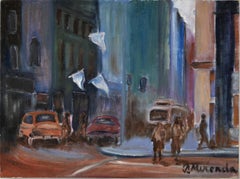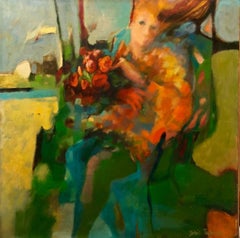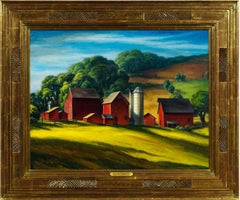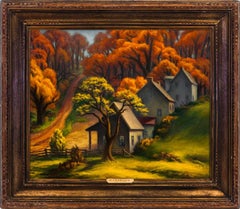RAD Miller Art
to
1
1
1
1
Overall Height
to
Overall Width
to
1
1
1
1
1
1
1
1
6,910
3,229
2,514
1,217
1
1
1
1
Artist: RAD Miller
"Girl in Pareu"
By RAD Miller
Located in Lambertville, NJ
Robert Alexander Darrah “R.A.D.” Miller (1905 - 1966)
Robert Alexander Darrah Miller, called “RAD” by his friends, was born in Philadelphia. He enrolled at the Pennsylvania Academy of the Fine Arts from 1923 to 1927 under the tutelage of Daniel Garber. In 1928, Miller moved to Bucks County where he would meet and marry Celia Belden Marshall, daughter of Dr. George M. Marshall, who at that time owned the Phillips Mill property.
Nearly a year later, in 1929, a committee headed by artist, William Lathrop, negotiated to purchase the Mill property from Dr. Marshall for the purpose of holding art exhibitions. Thus, the Phillips Mill Art Association was formed. RAD Miller was a regular exhibitor at the Phillips Mill with the traditional New Hope Impressionists. Many of the original founders of the New Hope Art Colony, set in their ways, frowned upon the concept of modernist painting. A decision was made by the Association to not include the growing group of modernist painters in the area to exhibit with them at Phillips Mill. Although clearly not a traditional impressionist, Miller was not being excluded with the others, largely because his father-in-law formerly owned the mill and was one of the Association’s board of directors. RAD was sympathetic to his fellow modernists. In 1933, he was one of the original members of the Independents, a group formed for modernist artists who chose to embark on a more non-traditional creative path. They would exhibit in tandem with the Impressionists but at different locations.
Around the time of his arrival to New Hope in 1928, Miller struck up a friendship with Thomas Hart Benton, and in 1932 he worked under Benton on a mural project. RAD’s paintings...
Category
1940s American Modern RAD Miller Art
Materials
Oil, Canvas
Related Items
Night Life in the City - Figurative Cityscape
Located in Soquel, CA
Night Life in the City - Figurative Cityscape
Mid 1960s cityscape by an unknown artist. Oil on artists board.
Image, 16"H x 20"W
Category
1960s American Modern RAD Miller Art
Materials
Oil, Canvas, Illustration Board
Autumn Wind, Large American Modernist Oil Painting Woman with Flowers
By Doris Turner
Located in Surfside, FL
Nice American Modernist Oil Painting. with old label verso. not dated but estimating it to the 70s. Not sure which Doris turner this is...
Category
1970s American Modern RAD Miller Art
Materials
Canvas, Oil
Six O'Clock
Located in Los Angeles, CA
Six O-Clock, c. 1942, oil on canvas, 30 x 20 inches, signed and titled several times verso of frame and stretcher (perhaps by another hand), marked “Rehn” several times on frame (for the Frank K. M. Rehn Galleries in New York City, who represented Craig at the time); Exhibited: 1) 18th Biennial Exhibition of Contemporary American Oil Paintings from March 21 to May 2, 1943 at The Corcoran Gallery of Art in Washington, D.C. #87, original price $450 (per catalog) (exhibition label verso), 2) Craig’s one-man show at the Frank K. M. Rehn Galleries, New York City, from October 26 to November 14, 1942, #10 (original price listed as $350); and 3) Exhibition of thirty paintings sponsored by the Harrisburg Art Association at the State Museum of Pennsylvania in Harrisburg in March, 1944 (concerning this exhibit, Penelope Redd of The Evening News (Harrisburg, Pennsylvania) wrote: “Other paintings that have overtones of superrealism inherent in the subjects include Tom Craig’s California nocturne, ‘Six O’Clock,’ two figures moving through the twilight . . . .” March 6, 1944, p. 13); another label verso from The Museum of Art of Toledo (Ohio): original frame: Provenance includes George Stern Gallery, Los Angeles, CA
About the Painting
Long before Chris Burden’s iconic installation outside of the Los Angeles County Museum of Art, Urban Light, another artist, Tom Craig, made Southern California streetlights the subject of one of his early 1940s paintings. Consisting of dozens of recycled streetlights from the 1920s and 1930s forming a classical colonnade at the museum’s entrance, Burden’s Urban Light has become a symbol of Los Angeles. For Burden, the streetlights represent what constitutes an advanced society, something “safe after dark and beautiful to behold.” It seems that Craig is playing on the same theme in Six O-Clock. Although we see two hunched figures trudging along the sidewalk at the end of a long day, the real stars of this painting are the streetlights which brighten the twilight and silhouette another iconic symbol of Los Angeles, the palm trees in the distance. Mountains in the background and the distant view of a suburban neighborhood join the streetlights and palm trees as classic subject matter for a California Scene painting, but Craig gives us a twist by depicting the scene not as a sun-drenched natural expanse. Rather, Craig uses thin layers of oil paint, mimicking the watercolor technique for which he is most famous, to show us the twinkling beauty of manmade light and the safety it affords. Although Southern California is a land of natural wonders, the interventions of humanity are already everywhere in Los Angeles and as one critic noted, the resulting painting has an air of “superrealism.”
About the Artist
Thomas Theodore Craig was a well-known fixture in the Southern California art scene. He was born in Upland California. Craig graduated with a degree in botany from Pomona College and studied painting at Pamona and the Chouinard Art School with Stanton MacDonald-Wright and Barse Miller among others. He became close friends with fellow artist Milford Zornes...
Category
1940s American Modern RAD Miller Art
Materials
Canvas, Oil
Gold Mine, Central City, Colorado
By Joseph Meert
Located in Los Angeles, CA
This painting is part of our exhibition America Coast to Coast: Artists of the 1930s
Goldmine, Central City, Colorado, oil on canvas, 36 x 28 inches, c. 1936, signed lower right, ex collection of Platt Fine Art, Chicago, Illinois (label verso).
About the Painting
Joseph Meert’s painting, Goldmine, Central City, Colorado, depicts the short-lived resurrection of a once prominent city just outside Denver. Central City was founded in 1859 soon after John Gregory struck gold in the area. As word spread, thousands of miners converged into “Gregory’s Gulch” and its surroundings became known as the “richest square mile on earth.” Mining production quickly increased resulting in Central City to becoming Colorado’s largest city in the early 1860s. Despite some technical difficulties transitioning to lode mining and the rise of competition from Leadville, Central City remained an economic boom town through the turn of the century. But, with every boom, there is a bust. World War I marked the end of Central City’s prominence as ore production ground to a halt and by 1925, the town’s population shrank to only 400 people. The desperation of the Great Depression and a nearly 100% increase in the price of gold lured labor and capital back to Central City. Meert painted in Colorado during the mid-1930s, a time when he created his most desirable works. It is during this period of renaissance that Meert captures one of Central City's outlying dirt streets bordered by 19th century wooden houses from the town's heyday and the more recently installed electric lines leading to a distant gold mine. A lone figure trudges up the hill, a mother with a baby in her arms, putting us in mind of the rebirth of the town itself. Meert had solo exhibitions at the Colorado Springs Fine Arts Center in 1936 and the Denver Art Museum. Although it is not known whether Goldmine, Central City was included in either of these exhibitions, it seems likely. Moreover, the painting is closely related to Meert’s painting, The Old Road, which was painted in 1936 and exhibited at the Corcoran Gallery of Art in Washington, DC and at the Dallas Museum of Art.
About the Artist
Joseph Meert was a well-regarded painter and muralist, who initially made a name for himself in the American Scene and later as an abstract expressionist. Although initially successful, Meert struggled financially and with mental illness later in life. He was born in Brussels, Belgium, but moved with his family to Kansas City, Missouri. As a child, a chance encounter at the Union Pacific Railyard changed his life. Meert happened upon a worker repainting and stenciling a design on a railroad car. Meert later recalled that this experience introduced him to the idea of being a painter. Without support from his father, Meert obtained a working scholarship to the Kansas City Art Institute. After four years at the Kansas City Art Institute, Meert studied seven years at the Art Students League and in Europe and Los Angeles. At the Art Students League, Meert fell under the spell of Thomas Hart Benton and Stanton MacDonald-Wright. In 1931, he befriended Jackson Pollock. By 1934, Meert was part of the Public Works of Art Project when he met his wife, Margaret Mullin...
Category
1930s American Modern RAD Miller Art
Materials
Oil, Canvas
The Demogogue
Located in Los Angeles, CA
The Demagogue or Tale in a Tub, 1952, oil on canvas, 20 x 24 inches, signed, titled, and dated verso
About the Painting
The Demagogue is an iconic Bendor Mark painting from the prime of his post-war period. Beginning early in his career, Mark was fascinated with depictions of the human figure and their capacity to tell stories of the world around him. Mark was a keen observer of his times and in The Demagogue we see Mark’s portrayal of a faithless politician holding up a “V” for victory sign as he appeals to the wanton desires and prejudices of the masses. Below the demagogue is a swirl of humanity representing the common man who is being pushed down by the powerful, while the robed figure of liberty with her scales of justice held high is brushed aside. Behind the demagogue, Mark places two other powerful supporting institutions which were often co-opted by the world’s dictators, the Church and the Military. Mark was an internationalist, so it is difficult to know exactly which demagogue inspired him to create this work, but in 1952 there were many to choose from. Whether depicting Argentina’s Peron (the demagogue and the women to the right resemble Juan and Eva Peron), Spain’s Franco or the United States’ homegrown fear mongers like Joseph McCarthy, Mark tells a universal story that unfolded in dramatic fashion during the post-war period as nations and their peoples grappled with authoritarianism and anti-democratic impulses. Stylistically, The Demagogue draws on the elements which make Mark’s work from this period immediately recognizable, a saturated palette, a closely packed and frenetic composition, exaggerated figuration and stylized facial features. But, above all, we see Mark’s ability to tell the stories of the rich and powerful and their ability to oppress. Like Mark’s work in the collection of the Whitney Museum of American Art (The Hourglass - 1950-51) and the Los Angeles County Museum of Art (Execution – 1940), The Demagogue pulls no punches, as the artist lays bare the threats to freedom and basic human rights.
About the Artist
Bendor Mark was an American modernist and social realist painter. Born as Bernard Marcus on June 5, 1912, in Brooklyn, New York, Mark trained at The Cooper Union during the 1920s where he studied with William Brantley van Ingen and became a prize-winning artist with a focus on painting the human figure. After his time at Cooper, Mark continued to live in New York and worked as a commercial artist and textile designer in addition to his pursuit of a career in painting. Like many Depression Era artists, Mark engaged with social progressives and in 1934, he joined the Artist’s Union which had the goal of advancing artists’ position as “worker.” Mark’s painting, Restaurant, which is now in the permanent collection of the Smithsonian American Art Museum, appeared in the February 1936 edition of the Union’s publication, Art Front, as part of a review of an exhibition at ACA Gallery in New York.
Mark worked on the Federal Art Project and by the mid- to late-1930s, began a series of paintings exploring the working conditions and hazards of the mining industry. Mark believed that miners were “in the forefront of the struggle for emancipation” and that the mere “struggle for existence is like moving mountains.” He became passionate about the Spanish Civil War and painted sympathetic images in support of the Spanish Republic. Mark was a premature anti-fascist and throughout his career painted works critical of dictators and other oppressors. During the late 1930s, Mark entered mural competitions with designs influenced by the Mexican muralists, taught adult art education in Queens, New York, and was an instructor at the WPA’s Queensboro Art Center. He was so committed to socially progressive art that by 1934, he had changed his name to Bendor Mark, in part, to distinguish his social realist paintings from his earlier work.
During World War II, Mark worked as an artist for military contractors. After the war, he was employed as a graphic artist and in the printing industry before moving to Southern California in 1948, where he returned to a fine art practice the following year with politically and socially charged images which reflected his view of the shortcomings of the post-War period, the continued threat of fascism, and the international tensions of the Cold War. As the mood of the country shifted towards the right during the McCarthy Era and the art world’s attention focused on abstraction at the expense of figuration, Mark’s career as a painter suffered.
From the 1950s through the 1980s, Mark continued to depict the events that shaped the world around him, often employing a highly stylized approach characterized by dynamic multi-figure compositions, a subtle muted palette, and exaggerated expressive features. A review of Mark’s oeuvre suggests that few people escaped Mark’s attention. He painted presidents, prime ministers, royalty, evangelists, musicians, and dictators (and their henchman), along with miners, farm workers, the urban poor, protesters, the unemployed and dispossessed. He laid bare the arrogance, cruelty, and hypocrisy of the world’s elites. Mark noted, “A work of art cannot be fully appreciated or wholly understood without considering the socio-political and cultural ambience that gave it birth.” He continued, “I have the ability to foresee the direction of social and political events while they are actually taking place.” He was not himself a direct political activist, however. Although Mark commented, “It’s a misconception to separate art from the social aspect of life,” he viewed artists as being neutral. According to Mark, “An apolitical attitude reflects the fact that the artist is passive. . . An artist never affects society; he merely reflects it.”
In addition to the Mexican Muralists, Mark was influenced by the old masters Rembrandt, Michelangelo, and Masaccio, as well as the more modern master, Van Gogh. Mark’s writings directly acknowledge these influences and archival material from his estate includes magazine articles, pamphlets and transparencies related to these artists. Mark also collected materials related to several of his social realist contemporaries, including Reginald Marsh, Ben Shahn, Leonard Baskin, and Raphael Soyer, who was Mark’s good friend. For years, Soyer sent Mark holiday cards and Soyer inscribed a message of friendship on a self-portrait he gifted to Mark in the 1970s, all of which are still held in the collection of Mark’s family.
From the late 1920s through the mid-1950s, Mark’s work was well received. His paintings won prizes and were accepted into major juried exhibitions including at the Brooklyn Museum, the New York World’s Fair and the Metropolitan Museum of Art. He gained national recognition for paintings depicting the oppressed and the common worker. Despite the decline in popularity of representational art during the 1950s and 1960s, Mark stayed true to his interest in depicting the human figure and by the last two decades of his life, his work underwent a reassessment as curators included Mark’s paintings in exhibitions showcasing the role of labor in art during the Depression Era. This recognition continued in recent years when Mark was honored by having his work included in the Whitney Museum of American Art’s ground-breaking exhibition, Vida Americana, which explored the pioneering role that the Mexican muralists played in the development of modern American art during the inter-war period. The influence of Rivera, Siqueiros and Orozco on Mark is unmistakable and his paintings from the 1950s (and beyond) sit comfortably in dialogue with other Los Angeles artists who continued to paint in the social realist tradition long after the mainstream art world had moved toward abstraction. Mark’s concern for underserved Brown and Black communities was shared with artists such as Charles White and his ally, Edward Biberman...
Category
Mid-20th Century American Modern RAD Miller Art
Materials
Oil, Canvas
Edgar Yeager Figurative Interior Scene
By Edgar Yaeger
Located in Detroit, MI
SALE ONE WEEK ONLY
Yaeger was an American Modernist painter from Detroit, Michigan, who is credited with being one of the first painters in this style. The portrait “Untitled” easil...
Category
1980s American Modern RAD Miller Art
Materials
Oil, Canvas
"Cowboy Boots" - Bay Area Figurative Movement
By Patricia Gren-Haynes
Located in Soquel, CA
Bay Area School figurative of a cowboy and hats by Berkeley artist Patricia Gren Hayes (American, b- 1932), circa 1983. Signed "Gren Hayes 1983" upper center and signed and titled "Cowboy Boots" on verso. Unframed. Size: 16"H x 20"W.
Bay Area Figurative...
Category
1980s American Modern RAD Miller Art
Materials
Canvas, Oil
Yellow Symphony #1
Located in Bogotá, Bogotá
This horizontal painting on canvas contains several layers of color, with textures and transparencies, representing a dreamlike scene where fantastic animals and humans in yellow and...
Category
2010s American Modern RAD Miller Art
Materials
Oil, Canvas
Bay Area Figurative Movement -- Cigarette Break
By Patricia Gren Hayes
Located in Soquel, CA
Wonderful figurative by Patricia Gren Hayes (American, 20th Century). Signed on verso. Unframed. Size: 30"H x 40"W.
Bay Area Figurative / Bay Area Feminist Art Movement artist, Patricia Gren-Hayes, studied at Winnipeg Public Art School in 1950. She received early recognition in Museum and Gallery competitions and exhibitions and was awarded a Special Education in Art recognition by the Winnipeg Museum of Fine Art, and was awarded a scholarship to the Banff College of Fine Art. Further studies were at The University of Manitoba.
She was a Member of Winnipeg Free Press Sketch Club and was a Cartoonist and paste-up for a French-English bi-weekly, in Eastern Canada;
She studied outdoor impressionism in New York in 1960; in 1962, attended The California College of Arts and Crafts, and in 1976 B.A., U.C. Berkeley where she studied under Elmer Bischoff, David Simpson, Joan Brown, Felix Ruvolo, Yolanda Lopez and Vincent Perez...
Category
1960s American Modern RAD Miller Art
Materials
Oil, Canvas
1950s Abstract Figurative Composition with Brown, White, and Black, Oil Painting
Located in Denver, CO
1950s abstract oil on canvas painting by Henriette "Yetti" Stolz from 1956. Completed in shades of brown, white, black, and gray. Signed by the artist in the lower right corner. Presented in a vintage frame measuring 42 ¾ x 16 ¾ inches. Image size measures 42 ¼ x 16 ¼ inches.
Provenance: Estate of the Artist, Henriette "Yetti" Stolz
Painting is in good condition - please contact us for a detailed condition report.
About the Artist:
Henriette “Yetti” Stolz was born in Serbia in 1935 ( and is still living ). Her family emigrated to Denver, Colorado, in the early 1950s after WWII and she attended East High School before studying art at Colorado College, in Colorado Springs in the mid to late 50s. While there studying she would have been exposed to modernist artists working both at the college ( ie. Mary...
Category
1950s American Modern RAD Miller Art
Materials
Canvas, Oil
H 42.5 in W 16.75 in D 1.5 in
"Nude by the Mirror" Mid-Century Modern Expressionist and Cubist Figure
By Byron Browne
Located in New York, NY
Byron Browne (1907 - 1961)
Nude by a Mirror, 1958
Oil on canvas
26 x 20 inches
Signed lower right
Provenance:
Doyle New York, Doyle + Design, June 7, 2017, Lot 20
Born in Yonkers,...
Category
1950s American Modern RAD Miller Art
Materials
Oil, Canvas
"Shattered" WPA Mid 20th Century Modernism American Scene Surrealism Figurative
By Leon Bibel
Located in New York, NY
"Shattered" WPA Mid 20th Century Modernism American Scene Surrealism Figurative
Estate stamp on the stretcher, verso. Provenance: Estate of the artist. 20 x 24 inches.
BIO
Leon Bibel continued painting through 1941 and resumed work in both painting and especially wood sculpture by 1960. He worked until his very last day in 1995. His last series of large wood sculptures were modeled on spice boxes, which were miniature buildings...
Category
1930s American Modern RAD Miller Art
Materials
Canvas, Oil
Previously Available Items
"Solebury Hills"
By RAD Miller
Located in Lambertville, NJ
Jim’s of Lambertville is proud to offer this artwork.
Complemented by a hand carved and gilt frame.
Robert Alexander Darrah “R.A.D.” Miller (1905 - 1966)
Robert Alexander Darrah Miller, called “RAD” by his friends, was born in Philadelphia. He enrolled at the Pennsylvania Academy of the Fine Arts from 1923 to 1927 under the tutelage of Daniel Garber. In 1928, Miller moved to Bucks County where he would meet and marry Celia Belden Marshall, daughter of Dr. George M. Marshall, who at that time owned the Phillips Mill property.
Nearly a year later, in 1929, a committee headed by artist, William Lathrop, negotiated to purchase the Mill property from Dr. Marshall for the purpose of holding art exhibitions. Thus, the Phillips Mill Art Association was formed. RAD Miller was a regular exhibitor at the Phillips Mill with the traditional New Hope Impressionists. Many of the original founders of the New Hope Art Colony, set in their ways, frowned upon the concept of modernist painting. A decision was made by the Association to not include the growing group of modernist painters in the area to exhibit with them at Phillips Mill. Although clearly not a traditional impressionist, Miller was not being excluded with the others, largely because his father-in-law formerly owned the mill and was one of the Association’s board of directors. RAD was sympathetic to his fellow modernists. In 1933, he was one of the original members of the Independents, a group formed for modernist artists who chose to embark on a more non-traditional creative path. They would exhibit in tandem with the Impressionists but at different locations.
Around the time of his arrival to New Hope in 1928, Miller struck up a friendship with Thomas Hart Benton, and in 1932 he worked under Benton on a mural project. RAD’s paintings...
Category
1930s American Modern RAD Miller Art
Materials
Canvas, Oil
"Oak Grove"
By RAD Miller
Located in Lambertville, NJ
Jim’s of Lambertville is proud to offer this artwork by:
Robert Alexander Darrah “R.A.D.” Miller (1905 - 1966)
Robert Alexander Darrah Miller, called “RAD...
Category
1930s American Modern RAD Miller Art
Materials
Canvas, Oil
Rad Miller art for sale on 1stDibs.
Find a wide variety of authentic RAD Miller art available for sale on 1stDibs. You can also browse by medium to find art by RAD Miller in canvas, fabric, oil paint and more. Much of the original work by this artist or collective was created during the 1940s and is mostly associated with the modern style. Not every interior allows for large RAD Miller art, so small editions measuring 48 inches across are available. Customers who are interested in this artist might also find the work of Paul Sample, Philip Evergood, and Arthur Beecher Carles. RAD Miller art prices can differ depending upon medium, time period and other attributes. On 1stDibs, the price for these items starts at $86,875 and tops out at $86,875, while the average work can sell for $86,875.




